by Winding Pathways | Feb 1, 2018 | Nature, Reflections/Profiles
Winter is the season of cold and darkness but there’s no reason to stay inside. It’s an outstanding time to enjoy the yard, a wetland, or a nearby woods, and these places are even more fascinating after dark than they are by day. Just use your night vision.
Winding Pathways encourages everyone to bundle up and go outside, especially after January or February’s darkness descends. Perhaps coyote songs or the haunting call of a barred owl will greet an intrepid nighttime listener.
There are some ways to best enjoy the darkness. Forget the flashlight. Well, maybe tuck it into a pocket but mostly keep it off. The best way to degrade night vision is using artificial light. Better to learn how to see in the dark.
Color Deficiency Can Help with Night Vision
Rich Patterson, a co-owner of Winding Pathways is lucky, sort of. He is unable to see the color red well. He’s not color blind as he can see blue, yellow, green, and some red shades, but he doesn’t see red as people with normal color vision so. For some reason, folks with color deficiency vision often have an outstanding ability to see after dark, and Rich enjoys his night vision, is often outside after dark, and hardly ever uses a flashlight.
There’s more to seeing after dark than having a color deficiency and better than average night vision. Everyone can use these techniques to negotiate the night and their homes at night without a flashlight.
Relax the eyes. Forget peering for detail, like the texture of a tree’s bark. Rather look out of the edges of the eyes for patterns that indicate a tree, rock, lawn, or some other object. Once the eyes are trained to work well at night it’s amazing how easy it is to walk a forest path, without a flashlight on a dark night. Or navigate your home in the dark and when the electricity goes off.
Foot Gear for Outdoor Walking
When outside, wear soft-soled shoes or in warm months, go barefoot. Thick hard-soled shoes, like hiking boots, make it impossible to feel the ground’s texture. Softer, pliable soles help a walker feel the trail. Native Americans knew this well and felt their way through dark forests through the soles of their moccasins.
It helps to mute electric lights in the house before venturing outdoors after dark. It takes a few minutes in darkness for eyes to adjust and allow more light to strike the retina.
Moon Shadows
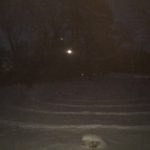
Full Moon Walk New Year’s Night
There is a surprising amount of light on a dark night especially in winter with snow on the ground. Even in the dark of the moon, stars cast enough light on a clear night for an adept human to walk without a flashlight. With a waxing or even waning full moon, plenty of light is cast on the ground for us to see. The moon’s reflection even casts shadows: Moon shadows!
Pre-Dawn Labyrinth Walking
Since late December 2017, Marion has walked the Phoenix Harmony Labyrinth every day and mostly in the early morning. In cold, wind, full-moon and dark of the moon, fog, and snow, she has quietly trod through the snow, watched the stars, noted animal tracks and generally enjoyed this interlude in the dark.
Cave Dark is Real Dark
An interesting experience is taking a cave tour. Visit Carlsbad Caverns, Mammoth Cave, or nearly any other cave and invariably the guide will gather everyone and turn off the lights. Down in a cave there is no light at all. When there’s no light it’s impossible to see, but fortunately, a backyard or woods at night is much lighter than the depths of a cavern, so seeing is possible.
Go outside after dark and have fun.
by Winding Pathways | Oct 17, 2024 | Ruminations
Routine Visit Leads to Cataract Surgery
A midsummer routine checkup by my ophthalmologist, Dr. Brian Privett, changed my vision – for the better.
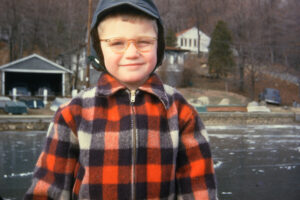
Wearing thick glasses was a way of life.
During most of my life, I have suffered from extreme myopia. I could see things inches in front of my eyes clearly but anything further away was only a blur. I wore thick glasses for years.
That changed nearly 20 years ago when I had PRK eye surgery. Similar to the better-known Lasik, a skilled eye surgeon and amazing technology altered my corneas. The impact was dramatic. For the first time, I could see distant objects clearly without glasses. And, I had peripheral vision not possible with my old glasses.
My vision remained outstanding, except for increasingly needing reading glasses for close work. This is a condition called presbyopia that virtually everyone experiences as they age.
Cataracts

Thick glasses
During my recent summer visit, Dr. Privett noted that my vision, although good, was somewhat diminished by growing cataracts. Most everyone also experiences them as they age. Cataracts are a stealth condition. They grow so slowly that it’s hard to detect a loss of vision. All I was aware of was increasing difficulty driving at night. Oncoming headlights and streetlights were surrounded by fog.
I wasn’t overly bothered and could have delayed cataract surgery, but during the visit Dr. Privett said, “Your cataracts aren’t too bad, but they will get worse and sooner or later you’ll need to have them removed and a new lens inserted. Having surgery sooner is a wise strategy as you’ll have more years to enjoy good vision and it’s often better to do surgery when a person is younger,”.
Decisions
That sparked an instant decision. I immediately scheduled surgery. Dr. Privett removed the cataract from my right eye and inserted a Vivity lens on July 31. He did the same procedure on my left eye a week later. Then followed about a month of eye drops.
It’s taken time to get accustomed to my “new” eyes. Perhaps the most striking experience was driving through Cedar Rapids on a dark night about a month after surgery. I was astounded at how clear the lights were. My night vision was excellent.
Adjustments
Cataract surgery isn’t perfect. I still need close-up reading glasses and my eyes are light sensitive. So, I carry and use readers and sunglasses depending on where I am and what I’m doing. In early October I ordered new glasses that include progressive lenses that should enable me to read and transitions that darken when I’m out in the sun and lighten inside the house. I’m expecting my new glasses to provide outstanding vision in many situations.
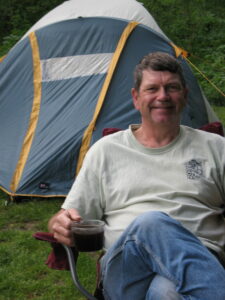
Enjoying life without glasses.
Modern eye surgery is miraculous and is the result of excellent medical research, advanced technology, and skilled surgeons like Dr. Privett. I encourage everyone to get periodic vision examinations and to follow the advice of their ophthalmologist.
Information
Many websites provide cataract information. One of my favorites is the Mayo Clinic. Dr. Privett and other ophthalmologists are affiliated with the Iowa Eye Center. The American Academy of Ophthalmology website helps people living anywhere to find a skilled eye physician near where they live.
by Winding Pathways | Aug 25, 2022 | (Sub)Urban Homesteading, Birds, Nature
While We Were Sleeping
We were tired on the evening of August 21. Crawling into bed at 9 pm we were oblivious to the traffic jam winging over our insulated roof. Late August. The fall bird migration has started. That night it picked up steam.
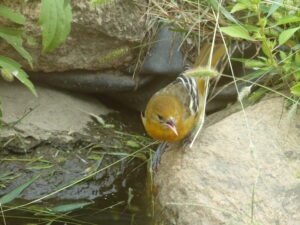
Birds stop for a drink and to fill up on the berries nearby.
In the morning we checked the BirdCast Migration Database and were astounded to learn that 883,000 birds crossed Linn County, Iowa, where we live, the evening before. Heading south, large numbers of birds began streaming overhead shortly after we turned off our reading lights. Migration usually starts just after sunset and peaks in the first couple of hours of darkness, but last night birds streamed over most of the night going south at an average speed of 26 miles an hour at an altitude of up to 2400 feet.
Technology Merged with Observation
How do we know? Well, we didn’t sit on the roof with night vision optics. We merely logged into the Cornell Laboratory of Ornithology’s Migration Dashboard at birdcast.info.
The technology is almost as fascinating as the information it reveals. The Live Migration videos show the action through the night. Fascinating!
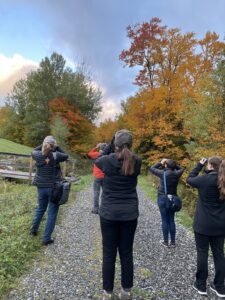
Pause to listen and look. Binoculars help.
The Lab collects data from 143 radar installations scattered across the country. This provides a clear picture of the number of birds migrating at any given time, their direction and speed, and how high they are flying. Radar can’t determine species, but years of data collected by ground observation and compiled by the Lab through eBird helps give an accurate picture of the likely species on the move. The list shows that probably 14 species went overhead while we slept.
Until a few years ago we were casual birders. The amazing science and sharing the Lab of Ornithology provides fascinate us and has sensitized us to the marvel and beauty of birds, their amazing navigation ability, their adaptations, and, unfortunately, the threats they face.
Apps Enhance Birding Experience
We have the Lab’s Merlin and Bird apps on our phone. The first is a pocket-sized field guide packed with more information than old paper field guides ever were able to provide. It helps us identify an unknown species, see its range, and even hear its calls and songs. A new feature helps identify birds by their song. Click it on and hold the phone toward where the call is coming from, and it identifies the species, usually correctly.
eBird enables us to easily compile a list of birds sighted on a particular day and forward our data to the Lab. Thousands of birders worldwide send their data, giving the Lab invaluable information on where birds are and how they move……as well as population trends.
Technology and Birds! What’s Not to Love?
Love technology? Love birds? These wonderful tools provided free from the Cornell University Laboratory of Ornithology merge the two. It’s a portal to many pages and other sites that include everything from nest webcams to detailed information about each species. Kudos to the Lab.
by Winding Pathways | Feb 21, 2019 | Labyrinths, Wonderment
The subtleties of walking a labyrinth in fresh snow or in the dark have not been lost on me. Muscle memory, night vision, and simple observation help navigate the terrain when obvious landmarks are obscure.
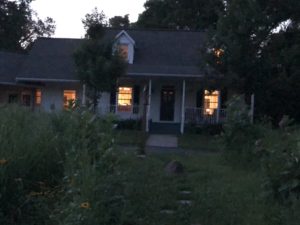
Muscle memory helps find the path in the dark.
Before the snow fell, when I walk the labyrinth in the dark, the memory of the path, familiarity with the number of steps to a turn, and the various plant heights help me navigate. The funny little statues and boulders along the way form the boundaries. Lights from passing cars not only illuminate the path briefly and also wreck night vision. So, counting steps and simply being aware of where I am on the labyrinth help keep me on the path.
With snow on the ground, the snowshoes make terrific “pat down” equipment and after a few times walking is easy. So, until a new snow, I can just wear boots. Stay on the beaten path or find myself “post-holing” through deep snow.
The brilliance of a sunny day can be confusing, so after a fresh snowfall, I look for the burned stems of plants and the slight depression of past walks as guides. And, how the drifted snow reveals a different texture is fascinating.
Odd marks in the snow capture my attention. Little holes that appear from nowhere, then tiny tracks of a rodent, then another little hole where it dropped back in the security and relative warmth of the snow tunnels.
The fate of the incautious rodent is evident where tracks suddenly disappear with telltale feather strokes on the snow. Whoooo’s for lunch?
Walking the labyrinth in winter brings its own rewards.
by Winding Pathways | Dec 14, 2017 | Preparedness
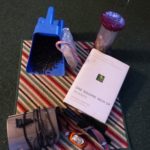
Stocking stuffers that will see use year round.
As the rush for Holiday gifts gets into full swing, we sometimes wonder how to “fill” those stockings with meaningful, fun and inexpensive stuffers. Here are some of Winding Pathways favorite items to be prepared for long dark nights and to simply enjoy cozy winter evenings.
Tops for us are flashlights. I once overheard women talking about how when the power went off one summer night they could not find their way around their own home and didn’t know where their flashlights were. Wow!
While we are adept at and comfortable with finding our way around our home, yard and even motel rooms in the dark, we always have a flashlight with us to use as needed.
Our advice is: First, learn your home, especially in the dark. Good night vision is important. Second, have handy a variety of flashlights and sizes. In the bedroom, bathroom, kitchen, den, and basement. We have small ones at the bedside, backpacker headlamps that fit over stocking caps and large handheld spotlights in strategic places. Remember to check batteries and have extras where you can get them easily.
We are outside a lot, so we like to have plenty of hand warmers with us. Several brands are available and some last longer than others. Some are made to fit into boots and tuck on your back. Anyone who works outside will appreciate a bunch of these. For the winter football fans, you can’t beat the warmers. The paper and mail carriers in your life will surely give a nod of thanks for receiving some warmers. And, those hardy winter bicyclists in your family will love you for including warmers in the stocking.
Because some folks enjoy feeding birds, birdseed and feeders are always great gifts. Use caution and buy quality seed and feeders. You will waste money and attract scavengers if you buy cheap seed loaded with milo, the small reddish seeds in a mix. So, go to a farm store or specialty bird feeding store for higher quality seed and feeders.
A totally practical gift is a weather radio that can be plugged in, run by batteries, or even be powered by a crank. Just Google “weather radio” and choose the one that fits your needs best. With winter upon us, get one!
Of course, many of us like to simply snuggle down on “long winter nights” and read a book. Bookstores are alive with exciting and intriguing books for winter reading. One we have discovered and pored over is One Square Inch of Silence by Gordon Hempton and John Grossmann.








